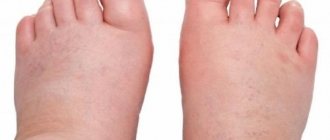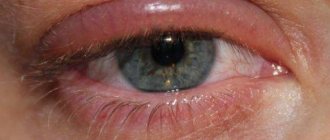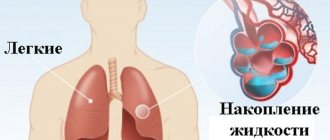Author:
Amelicheva Alena Aleksandrovna medical editor
Quincke's edema (angioedema) is a rapidly developing swelling of the deep layers of the skin and subcutaneous tissues due to exposure to allergens, drugs, and external factors.
Quincke's edema can occur in isolation, accompanied by urticaria (with rapid formation of blisters and severe itching), and lead to a life-threatening condition - anaphylactic shock.
The cause of acute angioedema is most often an allergic reaction, in which biologically active substances (mainly histamine) are released from mast cells, causing increased vascular permeability and extravasation (outpouring) of intravascular fluid. It is characterized by severe swelling of the eyelids, cheeks, lips, tongue, and in some cases the hands, feet, and genitals. With swelling of the upper respiratory tract, difficulty breathing is observed, with swelling of the mucous membrane of the gastrointestinal tract - severe abdominal pain, diarrhea, nausea, vomiting.
Nonallergic (drug-induced) angioedema can be caused by exposure to medications such as ACE inhibitors, nonsteroidal anti-inflammatory drugs, aspirin, and others. Also known are the chronic form of Quincke's edema (lasting more than 6 weeks), acquired (associated with the penetration of infection into the body, the presence of an autoimmune disease, a malignant neoplasm), idiopathic (the cause cannot be established) and, in very rare cases, hereditary (due to a deficiency of the C1 inhibitor complement system).
Causes
The pathogenesis of allergic Quincke's edema, regardless of the cause, occurs after a person comes into contact with an allergen, after which the active production of immunoglobulins begins. Histamine is released into the blood, which dilates the capillaries and increases their permeability, which is why the first symptoms of angioedema appear: swelling of the skin and mucous membranes.
Causes of angioedema:
- Food;
- animal wool and feathers;
- bites of various types of insects;
- chemical compounds and substances;
- house or street dust;
- medical supplies;
- chronic stress;
- hereditary causes of angioedema.
First aid for Quincke's edema.
How to relieve Quincke's edema? The first thing you should do when you find yourself next to a person with signs of angioedema is to call an ambulance.
What to do in case of Quincke's edema before the doctors arrive?
- First, unbutton the patient's clothes, loosen the tie, remove chains, beads, etc., thereby ensuring air flow. If you are indoors, open a window to let fresh air in.
- Make the patient more comfortable and try to calm him down by saying that doctors will arrive soon and begin treatment. This condition puts the patient into shock, which only worsens respiratory failure.
- If the problem began due to contact with an allergen, eliminate it if possible.
- Give the patient a tablet of any antihistamine that is in your home medicine cabinet. If the person cannot swallow, crush the tablet and place it under the person's tongue.
- Give the patient food more often if he can swallow, preferably with mineral water.
- If swelling is caused by contact with an allergen, give the patient activated carbon, Enterosgel or Polysorb to reduce the concentration of the allergic substance in the body.
- The patient's feet should be kept warm. You can place them in a bath of warm water or wrap them well.
- Place any vasoconstrictor drops into the patient's nose.
- It is necessary to measure the patient's blood pressure, and if it falls below 90, it is necessary to administer adrenaline to the patient.
Even if the patient feels better as a result of the measures provided, under no circumstances should one refuse medical care.
Symptoms
Quincke's edema has a sharp manifestation of the first symptoms and develops almost immediately after a person interacts with the provoking allergen. Swelling of the skin, subcutaneous fatty tissue and mucous membranes suddenly occurs. Angioedema on the face affects the eyelids, cheeks or lips. The eyes become slitted, the lips and cheeks become puffy. The tongue and mucous membrane of the oral cavity, neck, palms, and feet also swell. The skin in the affected area is pale.
Less common symptoms and signs of angioedema include dermatitis, itching, burning, pain and vesicular formation. When swelling of the larynx appears, difficulty and noise in breathing, coughing, and hoarseness occur. These angioneurotic signs can cause facial flushing, which is immediately replaced by pallor.
Localization of Quincke's edema in the visceral region is characterized by the occurrence of pathologies from the gastrointestinal tract, for example, intestinal obstruction. When the bladder is damaged, the pathology affects the urethra and complicates the process of urination.
Quincke's edema in children, as a rule, manifests itself as localized foci of swelling of the mucous membranes and skin.
Let's look deeper...
Why does swelling occur?
The human body contains a special substance - histamine. Normally, it is found in cells called mast cells. They are found in connective tissue, lymph nodes, spleen and bone marrow and do not show themselves for the time being. As soon as a focus of inflammation occurs in the body, mast cells receive a signal from other cells, become activated and release “charges” of histamine and other substances into the blood. Histamine causes expansion of capillaries and increases the permeability of their walls. This leads to swelling in the lesion, blood flow increases and slows down, which means more and more protective cells (neutrophils and lymphocytes) are concentrated. They will help the body cope with inflammation.
The same thing happens with Quincke's edema (only there is no focus of inflammation itself, and completely other factors, sometimes quite harmless, provoke the release of histamine). And here mast cells release histamine, which causes expansion of the capillaries, increases the permeability of their walls, which leads to tissue swelling. With Quincke's edema, the process involves the deep layers of the skin and subcutaneous tissue. Urticaria is the same as Quincke's edema according to the mechanism of development, only the upper layers of the skin are involved in the process. At the same time, at the site of histamine action, blood vessels dilate, connective fibers swell and small accumulations of inflammatory cells (mainly neutrophils and lymphocytes) appear.
Quincke's edema can occur as a result of three mechanisms: allergic, non-allergic and mixed.
- With an allergic mechanism (which is extremely rare for children under 3 years of age), the child first enters the allergen for the first time (in the form of a drug, food product, pollen or insect venom). The body takes it for an enemy agent (antigen) and produces an entire army of immunoglobulins (IgE antibodies) against it. Those, like guards, are attached to the membrane (shell) of mast cells like a palisade. These antibodies have a good and, most importantly, specific memory: they clearly remember what their antigen looks like. If the allergen arrives a second time, it binds to the IgE antibody on the surface of the mast cell, which leads to its destruction with the release of histamine. That is, Quincke's edema (like any other allergic reaction) develops when the antigen is repeatedly exposed.
- In a non-allergic reaction (which occurs much more often in children), histamine is released when some factor (insect venom, medicine, food coloring, etc.) directly affects the mast cell wall.
- Hereditary angioedema (Quincke's disease) is classified as mixed forms. There are invisible soldiers in the blood (complement system from the Latin complementum - addition), of which there are about 20 (01, 02, etc.). If a foreign agent enters the blood, they begin to actively influence each other. To make it easy to imagine: when meeting with a “stranger,” the first 01 wakes up and pushes the second 02; he bothers the third 03 (the third is sometimes activated without the first two); the third - the fourth, and so on - until a “heap of small things” is formed, which with its power breaks through the cell wall. In fact, these are, of course, not soldiers, but proteins that are in an inactive state. They would be happy to constantly activate and destroy cells (not only foreign ones, but also their own), but they are hampered by their bosses (inhibitor proteins), who constantly suppress their activity.
Problems with a genetic breakdown arise when there is little (from 5 to 30% of the norm) in the blood of those most formidable bosses - protein 01 or 03 inhibitor. Protein 01 in this case is happy to try: it “blows the whistle” for any unnecessary reason. A child cuts himself, gets nervous, becomes hypothermic, undergoes surgery - complement is activated and Quincke's edema occurs, and often the most unfavorable option is with swelling of the larynx, less often - of the gastrointestinal tract or meninges. When interviewed, it turns out that in the family from generation to generation there have been cases of laryngeal edema in relatives. This allows us to suspect the hereditary nature of the edema. Fortunately, such cases of the disease are very rare.
Treatment
When diagnosed with Quincke's edema, treatment must be undertaken immediately. When providing pre-medical first aid, it is important not to get confused and know exactly what to do in case of Quincke's edema. It is necessary to urgently call an ambulance and before it arrives:
- interrupt the patient's contact with the allergen;
- Apply a cooling compress and ice to the affected area;
- in case of an insect, snake, bee or other animal bite, apply a pressure bandage;
- loosen the patient's clothing;
- organize air flow;
- if the pathology is localized in the legs, lay the person down and raise the legs;
- if swelling occurs in the upper part of the body, help the person take a sitting position;
- give antihistamines (Loratadine, Suprastin).
It is important to know what angioedema looks like, how it manifests itself and remember the clinical recommendations for first aid.
The doctor conducts an examination, finds out what exactly is swelling in the patient during the angioedema process, how to treat it and what antihistamines and other drugs to prescribe for Quincke's edema.
First of all, treatment is aimed at stopping the allergic reaction. Medicines for edema are antihistamines, glucocorticosteroids (Dexamethasone), diuretics. If breathing is difficult or impossible due to swelling of the airways, adrenaline is used. In severe complicated situations, endotracheal intubation is performed.
Clinical manifestations of anaphylactic shock
Early signs are a feeling of heat, a feeling of fear, erythema, itching of the facial skin. In the future, allergic laryngeal stenosis, bronchospasm, hemodynamic disturbances (shock), dyspeptic syndrome, and Quincke's edema may develop. Usually 2-3 syndromes predominate; death most often occurs from acute respiratory failure. There are lightning-fast forms of shock with a fatal outcome within 5-10 minutes. The cause of death was acute hemodynamic failure and asphyxia.
Depending on the leading clinical syndrome, two variants of the fulminant course of anaphylactic shock are distinguished
- With the development of acute respiratory failure: suffocation and development of asphyxia due to obstruction of the upper respiratory tract, middle and small bronchi due to developed bronchospasm and edema. With the progression of respiratory failure and the development of adrenal failure, death may occur;
- With the development of acute vascular insufficiency (collapse), there is a progressive drop in blood pressure, a threadlike pulse, accompanied by pallor and cyanosis of the skin and a sharp weakening of cardiac activity. Cardiogenic shock may develop due to coronary insufficiency. Next comes loss of consciousness and convulsions. As the symptoms of cardiovascular failure increase, cardiac and respiratory arrest occurs.
A cerebral version of shock may be observed (with a predominance in the clinical picture of symptoms of damage to the nervous system) - there is a dysfunction of the central nervous system, manifested by agitation, a feeling of fear, loss of consciousness, convulsions, cerebral edema or clinical manifestations such as epilepsy.
Rarely, anaphylactic shock occurs with a gradual development of clinical symptoms (within 24 hours), after a prodromal period characterized by a state of discomfort, difficulty breathing, and the appearance of polymorphic allergic rashes.
Emergency care for anaphylactic shock
- stop administering the drug, provide access to the vein;
- Lay the patient down, turn his head to the side, extend the lower jaw (to prevent retraction of the tongue, asphyxia and aspiration of vomit), provide access to fresh air, and free him from constricting clothing. Work in pairs or in a team, call resuscitation for yourself!!!;
- inject the injection site of the allergen with 0.18% epinephrine (adrenaline) solution (0.1 ml/year of life in 5.0 ml of isotonic solution) and apply cold.
- Apply a tourniquet above the injection site of the allergen (bite) without squeezing the arteries (for 30 minutes);
- simultaneously enter:
- 0.18% solution of epinephrine (adrenaline) 0.05 - 0.1 ml/year of life (no more than 1 ml) intravenously or intramuscularly into the root of the tongue or pour under the tongue,
- 3% solution of prednisolone 3-5 mg/kg intravenously (intramuscularly, preferably in the muscles of the floor of the mouth) or, preferably, 0.4% solution of dexamethasone (in 1 ml - 4 mg) calculated as prednisolone (1:4) IV.
Upon arrival of the ambulance team:
- administer intravenously a 0.18% solution of epinephrine (adrenaline) 0.05 - 0.1 ml/year of life in 10 ml of isotonic sodium chloride solution;
- administer intravenously: 3% prednisolone solution 2-4 mg/kg (in 1 ml – 30 mg) or 0.4% dexamethasone solution 0.3-0.6 mg/kg (in 1 ml – 4 mg);
- replenishment of blood volume: administer intravenously a stream of glucose-salt solutions (10% glucose solution, Ringer's Dissol, etc.) until blood pressure stabilizes, then drip 10-20 ml/kg.
- if low blood pressure persists, continue intravenous jet administration of 0.1% adrenaline solution 0.05 ml/year of life (in total no more than 5 mg) every 10-15 minutes. until the condition improves, every 5 minutes (monitor blood pressure, pulse)
- Carrying out syndromic therapy, depending on the type of anaphylactic shock:
1) for bronchospasm:
- oxygen therapy,
- administer intravenously a 2.4% solution of aminophylline - 0.5-1.0 ml/year of life (4 mg/kg, no more than 10 ml) or inhalation of Berotek, Berodual (GCS and β2-adrenergic agonists) ,
- if the measures taken are ineffective, tracheal intubation is performed.
2) with cardiovascular failure and the development of pulmonary edema:
- intravenously 0.3-0.5 ml of 0.05% strophanthin solution in 10 ml of 40% glucose solution;
- administer 1% solution of furosemide (Lasix) 0.1-0.2 ml/kg (1-2 mg/kg) intramuscularly or intravenously. If there is no effect after 15-20 minutes. – repeat the administration of the drug;
- With increasing clinical signs of pulmonary edema - 4% dopamine solution intravenously titrated to 3-6 mcg/kg/min (dosage is selected individually);
- O2 inhalation with alcohol vapor,
- indirect cardiac massage, mouth-to-mouth breathing, mouth-to-nose breathing, mechanical ventilation.
3) If the cause of anaphylactic shock is penicillin or bicillin , then penicillinase 1,000,000 units in 2.0 ml of isotonic solution is injected intramuscularly.
4) For convulsions - administration of a 0.5% solution of diazepam (seduxen) 0.05-0.1 ml/kg (0.2-0.3 mg/kg) intramuscularly, intravenously.
Call the resuscitation team. After stabilization of blood pressure, emergency hospitalization on a stretcher in the intensive care unit of the hospital under the control of life support functions and general somatic symptoms (relapse of anaphylaxis!)
Frequently asked questions about Quincke's edema
How to treat Quincke's edema?
For treatment, tablets for Quincke's edema are used, namely, antihistamine drugs, glucocorticoids, and diuretics. Dexamethasone for allergic Quincke's edema gives a very effective effect and helps stop the reaction. A subcutaneous injection of adrenaline for Quincke's edema reduces blood pressure and restores breathing.
How does Quincke's edema manifest?
Angioedema manifests itself in rapidly developing swelling of areas with developed subcutaneous tissue - the face, larynx, neck, palms or feet. Sometimes burning and itching occur. The affected areas have increased density and are not pressed when pressed.
Is it possible to cure angioedema?
Symptoms usually disappear after two to three days. But if it does not subside for more than three hours, you should seek qualified help. With properly selected treatment for Quincke's edema and taking prescribed medications, the prognosis for recovery is favorable. The course of therapy depends on the causes of the allergic reaction and the presence of concomitant diseases.
Prices
| Name of service (price list incomplete) | Price |
| Appointment (examination, consultation) with an allergist-immunologist, primary, therapeutic and diagnostic, outpatient | 1750 rub. |
| Prescription of treatment regimen (for up to 1 month) | 1800 rub. |
| Consultation (interpretation) with analyzes from third parties | 2250 rub. |
| Consultation with a candidate of medical sciences | 2500 rub. |
| Allergen-specific immunotherapy (ASIT) - maintenance course (excluding the cost of the drug) | 8100 rub. |
Causes of angioedema in adults
The cause of angioedema is exposure to an allergen (for example, peanuts, chocolate). However, either idiopathic edema of unknown etiology or poorly correlated with allergen exposure is common. Angioedema may reflect some kind of somatic pathology: diseases of the gastrointestinal tract, dysfunction of the endocrine system, chronic foci of infection, parasitic infestations, systemic diseases.
The cause of angioedema in adults can be chemicals, including medications, and physical factors (temperature, pressure). Quincke's edema often develops under the influence of several factors at once.
The hereditary form (HAE) often remains undetected for a long time, since its symptoms may resemble those of allergies, intestinal colic or other pathological conditions. An important point is that HAE is not relieved by antihistamines and glucocorticosteroids. How to treat hereditary angioedema? Therapy for HAE is fundamentally different from therapy for angioedema. In the acute period, hereditary angioedema is relieved by the administration of fresh or fresh frozen native plasma, intravenous administration of tranexamic or aminocaproic acid, danazol, Lasix.
Diagnosis of urticaria
Before starting treatment, it is important to understand what exactly a person has such a strong allergic reaction to.
Only by removing this provoking factor from your usual life can you not be afraid that the symptoms of urticaria will appear again, and this is possible even after proper therapy. Most often, this type of allergy appears to food. It is possible to determine what exactly caused the rash by a blood test: the level of IgE antibodies to a mixture of food allergens is detected. First of all, you need to diagnose the presence of an allergic reaction to:
- nuts;
- vegetables and legumes;
- citrus fruits and fruits;
- seafood;
- cereal and sesame flour;
- fruits and melons;
- baby formula;
- fish;
- meat;
- mushrooms;
- loose leaf tea;
- goat milk.
In addition to food, allergic manifestations can also occur to other substances that surround us almost everywhere in life:
- mold fungi;
- pollen from early flowering trees;
- pollen of late-flowering trees;
- weed pollen;
- epithelium of domestic animals;
- house dust;
- house dust mite;
- poultry feather.
To identify the exact type of allergen, allergy tests are performed on certain foods.
It often happens that rashes appear due to seasonings and herbs used in cooking: paprika, cumin, cloves, basil, ginger, tarragon, thyme, marjoram, dill, bay leaf, black pepper, vanilla. Some types of fish may also be allergenic: cod, halibut, mackerel, and squid meat. But sometimes an allergic reaction in the form of urticaria develops to such familiar products as:
- cucumber;
- apricot;
- cherry;
- tomato;
- plum;
- grape;
- persimmon;
- carrot;
- beet;
- watermelon.
All tests are carried out only by a specialist laboratory technician. You cannot independently determine the presence of an allergy in the form of urticaria to a particular food product or substance. This can be life-threatening, since it is possible to develop not only Quincke's edema, but also anaphylactic shock.






